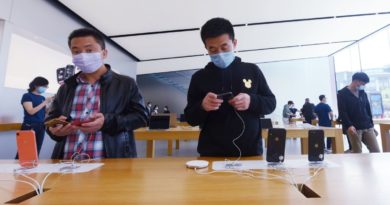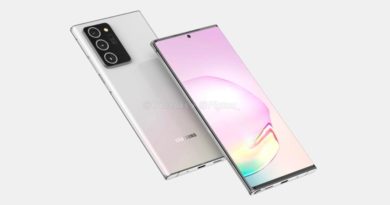Best iPhones in 2020
The game plan for getting one of the best iPhones is usually a simple one: wait for Apple’s fall release, and then get the new iPhone that best fits your needs.
That’s still a great strategy, but this year, you’re in for a longer wait than usual with the new iPhone 12 models. In recent years, Apple has unveiled its latest iPhones during the first couple weeks of September. But that’s not going to happen in 2020, after Apple said it’s not going to ship any new iPhones in September, likely because of production delays caused by the coronavirus pandemic. That means it’ll be October before you see a new iPhone.
Fortunately, if you need a new iPhone now, you have plenty of options to choose from in Apple’s current lineup, which include some of the best phones overall. And with the arrival of iOS 14 this fall, even current iPhones can expect new features and capabilities.
Here are our recommendations and rankings for the best iPhones available right at this moment.
What are the best iPhones?
Based on our testing, the iPhone 11 is the best iPhone for most people, given its powerful processor and the fact that its cameras support the same photo features as the pricer iPhone 11 Pro models even though the iPhone 11 gets by with just two rear cameras. You will miss out on the telephoto shooter and its 2x optical zoom, and the iPhone 11’s Liquid Retina LCD display isn’t quite as nice as the Pro’s OLED panels, but for most users, the $300 in savings will be worth it.
If you’re less constrained by budget, the iPhone 11 Pro Max is the iPhone to get, thanks to its bright, expansive OLED screen and long battery life. But it’s also the priciest iPhone available with a starting price of $1,099 — and that’s just for the 64GB configuration.
That’s why we think the new iPhone SE 2020 is so appealing. At $399, it’s the cheapest iPhone available, and it’s a compact phone for people who don’t care for 6-inch-plus screens. While you’ll make some tradeoffs — there’s just a single rear camera and the battery life disappointed in our testing — you still get a very powerful device with the same processor that Apple’s more expensive iPhones use. We think it’s a contender for the best cheap phone out there.
Apple’s $999 iPhone 11 Pro is another option for people who like compact phones, while people who like bigger screens but hate big prices can turn to the $599 iPhone XR. It doesn’t have the latest specs, but the XR receives regular software and security updates, and it’s still faster than a lot of the phones you can buy these days.
Those are the five models available through Apple. You might find additional models at discount carriers, but unless they’re available at a significant discount, you’re better off sticking with these newer iPhones.
The best iPhone you can buy right now
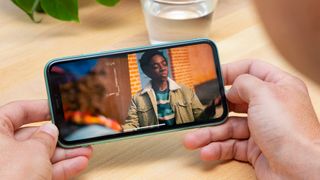

The iPhone 11 replaced the iPhone XR as the iPhone for everyone, and it’s proven to be Apple’s most popular smartphone. It’s easy to see why: While the iPhone XR debuted at $749 in 2018, the iPhone 11’s starting price has dropped to $699 — a full $300 lower than what Apple’s Pro series iPhones currently cost.
Even better, the trade-offs you make for that lower price are minimal. The iPhone 11 has the same A13 Bionic processor found in the iPhone 11 Pro, and its performance is on par with Apple’s pricier phones (and still well ahead of the top Android handsets). You are giving up a telephoto lens, as the iPhone 11 features a 12-MP wide angle and ultra wide angle shooters, but it’s capable of the same camera effects as the iPhone 11 Pro, including portrait shots, ultra wide angle selfies and Night Mode for better low-light photos. You can also expect more than 11 hours of battery life from the iPhone 11, though you’ll have to spring for a separately-sold fast-charging adapter to juice back up at the quickest speeds.
See our full iPhone 11 review.
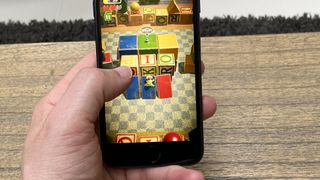
You can’t keep a good iPhone down, which is why Apple revived the iPhone SE four years after launching the original low-cost, compact iPhone. The iPhone SE 2020 is a little larger than before — adopting the 4.7-inch screen and form factor of the discontinued iPhone 8 — but it’s kept a low price that will appeal to iPhone fans looking for the best bargain around.
It’s not just the price that makes the iPhone SE so appealing. The phone runs on the same A13 processor you’ll find in all three iPhone 11 models, so the iPhone SE will remain a top-performing phone for years into the future, especially as regular iOS updates add new features. You’ll just get one rear camera with this phone, but it’s a good one, augmented by the A13’s Neural Engine to augment your photos with computational photography.
This isn’t the longest-lasting iPhone by any stretch of the imagination, as our iPhone SE 2020 battery tests found, and we wish that camera would support Apple’s Night mode for better low-light photography. But if you want some premium power in a phone that fits comfortably in one hand, the iPhone SE was built with you in mind.
Read our full iPhone SE 2020 review.
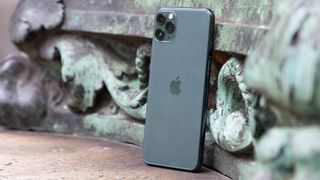
Apple says its iPhone Pro models are aimed at professionals who rely on their smartphone to get work done, though it’s not going to stop you from buying the iPhone 11 Pro Max if you want one of the best phones available. We’re particularly impressed by the iPhone 11 Pro Max’s Super Retina XDR display, which outshines other big-screen phones. Even with that expansive 6.5-inch screen and the powerful A13 Bionic processor inside the 11 Pro Max, this model has the longest-lasting battery Apple’s ever put in an iPhone. The iPhone 11 Pro Max lasted more than 11.5 hours on our battery test, placing it among devices with the best phone battery life.
New cameras also highlight the iPhone 11 Max Pro, with a 12-megapixel telephoto lens joining the 12-MP wide and ultra wide angle cameras Apple includes on the iPhone 11. The extra cameras are appreciated, particularly when the iPhone shows a preview of what the ultra-wide angle lens is capturing when you’re shooting the main lens. But the real improvement comes from software enhancements like a new Night Mode that helps the iPhone 11 Max produce low-light shots that match what you get from the best camera phones, though the quad-lens Galaxy S20 Ultra ratchets up the pressure on Apple.
We wish the iPhone 11 Pro Max came with enough storage to live up to that Pro moniker — the base model’s 64GB is too skimpy. But other features like an included fast charger and durable design make the iPhone 11 Pro Max the choice if money is no object.
Read our full iPhone 11 Pro Max review.
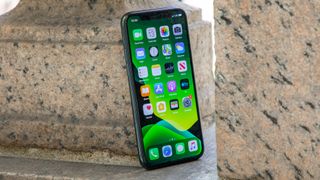
Between the iPhone 11’s low price and the iPhone 11 Pro Max’s giant screen and equally large battery life, it might be tempting to overlook the iPhone 11 Pro. But if you value phones that fit comfortably in the hand, this 5.8-inch device is the perfect iPhone for you. That screen is the same Super Retina XDR panel found on the 11 Pro Max, so you’ll get a seriously bright display with wide color support. You’ll enjoy the same three camera setup featured on the iPhone 11 Pro Max, too.
In fact, apart from battery life — which could be a lot better on the iPhone 11 Pro — you’re getting a lot of the same features found on the 11 Pro Max, such as an included fast charger, faster modem, and the ability to survive a plunge in up to 4 meters of water. All that comes in a more compact phone, which for fans of smaller devices, will be the best feature of all.
If it’s the compact size of the iPhone 11 Pro that appeals to you, be aware that Apple could soon release a smaller phone, which will likely be called the iPhone 9. It’s expected to be about the same size as the iPhone 8, but feature the A13 Bionic processor of the iPhone 11 Pro; it could also have a very low price tag based on reports of Apple’s 2020 product launch plans.
Read our full iPhone 11 Pro review.

The iPhone XR is proof you don’t have to pay top dollar to get one of the best iPhones, and now that the price has dropped to $599, it’s an even better buy. The XR has an LCD panel, not the OLED screen found in the more expensive iPhones, and you’ll have to get by with just a single rear camera while the similarly sized iPhone 11 features two lenses. But for many users, those won’t be significant sacrifices, especially in light of what you get in return.
Though the newer iPhone 11 models have a faster processor, the A12 Bionic powering the iPhone XR still outperforms many top Android smartphones. The iPhone XR also gets great battery life — on par with our iPhone 11 test results and only 15 minutes behind the iPhone 11 Pro Max’s 11 hour, 40 minute result. And if you value design, you’ll appreciate the rainbow of colors the iPhone XR comes in. The iPhone XR isn’t very compact, but it delivers a great balance of price and performance, even with the iPhone 11 delivering more features.
See our full iPhone XR review.
How to choose the best iPhone for you
The best way to determine the iPhone you should buy is to take stock of the features and capabilities that matter most to you. If battery life is especially important, seek out one of the Max or Plus variations; these larger phones have bigger batteries to match. What’s more, because iOS is known to be generally efficient in terms of energy consumption, even the smaller models tend to last longer than average on a charge.
If you’re basing your next iPhone purchase off camera quality, the top-tier Pro variants are easy recommendations, thanks to triple-lens designs that allow you to capture multiple different perspectives, from zoomed-out ultra wide-angle images to shallow depth-of-field portraits. They’re also remarkably good in challenging lighting scenarios, like when shooting in a dimly-lit indoor space, or outdoors at night.
All that said, if price is king, and saving the absolute most on your next smartphone purchase is your top priority, you should have no reservations about nabbing an iPhone SE 2020 or iPhone XR. These may be on the cheaper side of Apple’s range, but they’re still made of flagship-quality materials, with enough power and performance to sustain years of use.
However, be mindful of storage. Apple’s most recent iPhones start at $699 for the iPhone 11, with prices spiking upward for the iPhone 11 Pro ($999) and iPhone 11 Pro Max ($1,099). Those base prices get you a phone with 64GB of space, but if you want more capacity, be prepared for that price tag to go up. A 256GB iPhone 11 Pro will cost you $1,149, for example, while the 512GB model brings the price to $1,349.
If you buy your iPhone through Apple, you may be able to save money by trading in your current phone. Apple’s trade-in rebates range from up to $170 off for iPhone SE 2020 purchases to a potential $280 discount if you’re buying an iPhone 11 Pro model. You can save up to $220 on the iPhone 11 with a trade-in.
When Apple releases new iPhones, it cuts the price on the models it keeps around. The iPhone XR now costs less than $600, for example. That means if you wait until this fall’s iPhone 12 release, you could see prices drop on some of the models listed here — assuming Apple keeps them in the smartphone lineup.
But as we mentioned, the iPhone 12 isn’t expected until October at the earliest (though Apple still may hold a launch event in September). Apple is expected to release four new models — a 5.4-inch iPhone 12, a 6.1-inch iPhone 12 Max, a 6.1-inch iPhone 12 Pro and a 6.7-inch iPhone 12 Max. All four phones will have 5G connectivity and feature OLED screens. The Pro models are expected to add a LiDAR sensor similar to the one on the iPad Pro, and they could feature displays with faster 120Hz refresh rates.
If any of these rumored features strike your fancy, it may be worth holding out until later this year when the iPhone 12 debuts. Check out our iPhone 12 hub for the latest rumors on Apple’s upcoming phones.
All of the iPhones mentioned here run the latest version of iOS, Apple’s mobile operating system. And they’ll be able to upgrade to iOS 14, the new version that’s going to arrive in the fall around the same time as the iPhone 12. (In fact, iPhones dating back to the iPhone 6s and original iPhone SE will be able to run iOS 14.) Apple previewed iOS 14 at June’s Worldwide Developer Conference and a public beta for the update is coming this month.
How we test iPhones
As with any smartphone we test at Tom’s Guide, we evaluate iPhones for days in real-world use cases. We also benchmark Apple’s phones using a gamut of performance-measuring apps that allow us to compare iPhone performance to what Android devices are capable of. In addition to synthetic benchmarks, we also run real-world tests, including a video transcoding test in Adobe Premiere Rush that compares the iPhone’s processing speed with other devices.
In our lab, we use a light meter to ascertain display quality data, like brightness and color accuracy to help us evaluate the display of the best iPhones. Our proprietary battery test determines longevity on a charge by endlessly streaming webpages over an LTE network; we then recharge the iPhones to see how quickly they charge in 15-minute intervals.
To compare cameras, we take any iPhone we review out and shoot photos in a variety of settings. We also bring along a comparable smartphone to see how the iPhone’s photographic output measures up.
We explore Apple’s iOS improvements, test gaming performance and evaluate the phone’s speakers — and each of these factors play a part in our final verdict.
